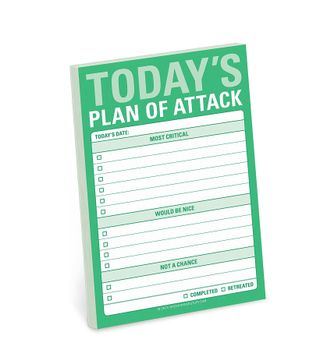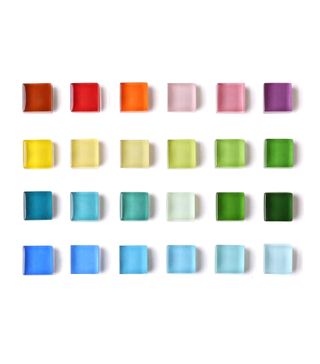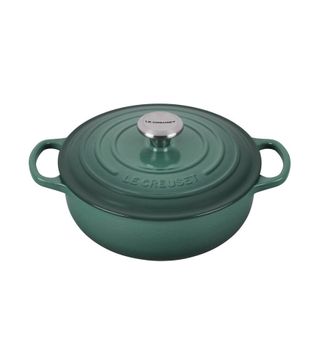15 Smart Budgeting Tips Finance Experts Want You to Know
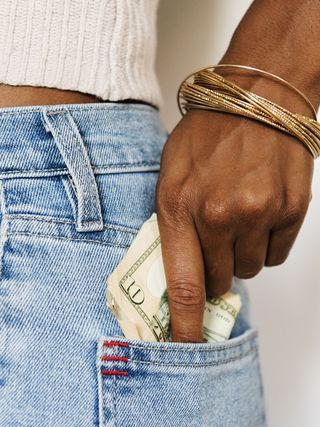
Budgeting or managing your finances can seem overwhelming at times. Where do you start? How do you create goals? And depending on your particular situation, you might not even feel like you can create a budget if you don't even have much to work with in the first place. The truth is, anyone and everyone should feel empowered to take control of their finances and learn the ins and outs of it all, whether you've got a huge disposable income or you're working on paying off a big chunk of debt. Knowledge is wealth and financial wellness is important.
"Everyone deserves to feel in control of their finances—and the practice of financial wellness can help you get there and give you the tools you need to feel confident about where your money is going!" says Sofia Figueroa, a certified financial planner at Ellevest. "Understanding what to include and prioritize in your budget is just as important as actually putting pen to paper and forming a game plan."
Creating a budget for yourself is a good first step if you're trying to get better control of your finances and manage your money. "It helps you assess your financial situation and become aware of where your money is going every month," says WalletHub analyst Jill Gonzalez. "You'll be able to see exactly what changes you should be making in your spending habits, or the income you need to be able to make ends meet. Start by simply listing how much money you make and what you spend it on and go from there."
Want to buy a car? Own a home? Go on a big vacation? Financial Advocate and Chief People Officer at Credit Karma, Colleen McCreary adds that a budget can be a north star for those who want to hold themselves accountable as they work toward a specific financial goal. "Whether it means getting out of debt, or slowing down impulse spending, the point of a budget is to help keep you on track. A good budget will help you find the balance between money coming in and money going out. It also helps uncover potentially unhealthy habits like overspending on unnecessary items."
Ready to create a plan? For how to get started on your budget and some other finance tips, take a look below.
1. Set Goals

"The first step is to set a goal for your finances," McCreary says. "Ask yourself what you're hoping to do with your money in the short and long term. Do you want to buy a house one day? Are you working toward paying off student loans? Are you just trying to get your spending in check?"
Figueroa breaks down the goal-setting process into two steps: One, making a list of your personal values (security, health, friendship, adventure, etc.) which will be different for everyone, and writing down all the things you want to accomplish (short-, mid-, long-term goals). Second, you'll want to clean up both of those lists. "First, narrow down your list of values to the three to five that are the most important in your life," she says. "Next, use those values to help you rank all of your goals. That way, when you go to create your budget and spending plan, you'll have a clear idea of what you need to include and which goal to work toward next."
And Gonzalez says that making sure you are specific about your timeline and the amount you want to set aside when it comes to your goals can help—and even breaking them down into smaller, monthly goals can help you stay on track.
2. Take a Look at Your Current Finances
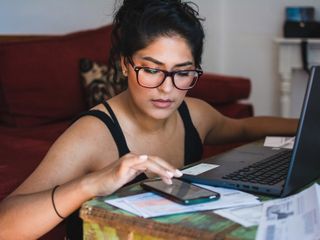
Gonzalez recommends gathering any information that can help you determine your monthly spending. Knowing what you're doing now can help you identify opportunities to switch things up, Figueroa adds. "Pulling credit card and bank statements is a simple way to get that information in front of you," she says. "There's no judgment here—it's simply about understanding what's happening now so you can make informed decisions about where you want to go!"
Look at the income you have coming in and project any expenses over the coming months. Try doing an audit of the last few months to see where you're spending the most. "See if you can spot trends in unnecessary spending that add up on a monthly basis and that you may have never noticed," McCreary suggests.
3. Try a Budget Formula

"There are a number of budget formats you can use, like the 50/30/20 budget, for example, where you divide your expenses into three categories—50% toward needs, 30% toward wants, and 20% toward savings or debts," McCreary says. "With the 50/30/20 budget, you're reducing the amount of time you spend detailing your finances, allowing you to focus more on the big picture instead."
Figueroa offers her clients the "One-Number Approach" to budgeting. "It involves calculating how much money they can afford to spend on 'flexible costs' (aka the things that might vary in cost—ones you have to make decisions about) each week," she says "Then you only have to remember that one number on a day-to-day basis. This weekly number can be easier to track than a monthly budget—plus, it makes it less likely that you'll run out of spending money later in the month." The one-number is used for necessary things, like groceries or gas, but also "fun" stuff like eating out, shopping, entertainment. She says that as long as you stay within this one number, you're free to spend the money each week however you like without guilt or shame.
Figueroa describes how you can calculate your "one number":
1. Start with the total amount of take-home pay you expect to earn during the month. This is what actually hits your bank account after taxes, retirement contributions, health deductions, etc.
2. Subtract all your monthly fixed costs or those that stay pretty much the same on a month-to-month basis (like rent, debt minimums, subscriptions).
3. Subtract the money you'll set aside for "Future You." These are your short- and long-term goals that you identified using your values! Saving, investing, and debt payments beyond the minimums.
4. Subtract the amount you need to save for non-monthly expenses. These are things that pop up throughout the year, just not on a monthly basis. Think travel, annual subscriptions, gifts, semi-annual insurance premiums, etc. Add up how much all these things cost per year, then divide by 12. You'll set aside that number on a monthly basis (and tap into it as those expenses come up).
5. What's left is your monthly flexible spending money. Divide your monthly flexible spending money by 4.3 (the average number of weeks in a month). This is your one number.
4. Keep Track

And don't forget to keep track of your spending and saving, whether that's through an app or with a simple spreadsheet. McCreary recommends making sure your tracker is somewhere visible, whether it's on your phone or taped to your fridge.
5. Pay Yourself First

"My number one budgeting tip would be to pay yourself first," Figueroa says. "I know it might sound cliché, but it is so important. Getting into the habit can set you up for long-term financial success and security. Even if it's just a small portion of your income now, do what you can! The idea here is to factor in your savings goals—so emergency savings, retirement, other investing—into your budget, so that each month you are making those contributions before you spend on any other expenses. That way, you know you're making progress toward all of those goals. And 'Future You' will thank you for that."
6. Don't Forget to Have Fun

It's okay to allocate some money for "fun" stuff, whether it's shopping, or splurging on a nice dinner, or going on a trip. McCreary reminds us that a budget isn't meant to prevent us from enjoying our lives, but to help us avoid spending money we don't have.
"Give yourself permission to use money in a way that makes you feel good," Figueroa says. "As long as you are still able to pay your bills, and not rely on debt (aka credit cards) for that fun stuff, you can just trust your budget. Don't worry about ordering that latte or taking that impromptu trip to Target if it's something you want—that is what your flexible money is for! The goal is to set spending boundaries or limits overall—not on every little thing. I also often suggest to clients that they work a 'miscellaneous' or 'fun stuff' category into their non-monthly expenses, so if they do want to do something a little more expensive periodically, they have some funds to tap into without the guilt."
7. Set Up Autopay
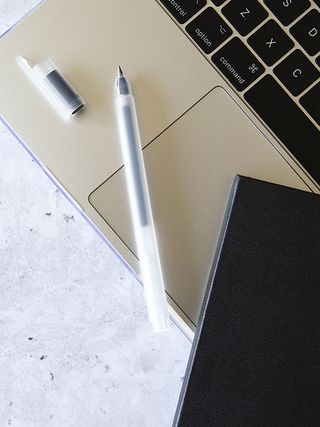
One way to keep yourself from overspending is putting all your fixed costs on autopay out of the same account where you get your paychecks, Figueroa says. This will leave you with fewer things to think about and less decision fatigue. "I also suggest using one card (either a credit card or a debit card associated with a secondary checking account) exclusively for your flexible spending," she adds. "That way, all you need to do to keep track of your "one-number" is to log into your account a few times a week and see how much you've charged or spent already."
8. Open a Dedicated Spending Account

"Open a dedicated checking account if you want to keep your spending in check," McCreary suggests. "There's no rule that says you can't have more than one checking account. You can put a certain amount of money on that debit card each week or each month based on your budget, and when the card runs out of money, you know it's time to stop spending. There are many options out there—like Credit Karma Money—that are free, easy to use, and don't have any hidden fees."
9. Allocate Certain Days for Spending

McCreary says you can also specify certain days for spending and not spending to keep it all in check. "Whether it's every Monday or the odd days of each month, mark your calendar on the days that you pledge to spend—or not spend—any money," she explains. "That means finding free activities for entertainment and cooking at home instead of ordering out. You may be surprised at how many seemingly small purchases add up over the course of a month, and how much you end up saving if you find certain days to avoid spending."
10. Tackle Debt

"Things like credit card debt can be expensive, especially if the interest rates are high," Figueroa says. "If possible, I'd try to transfer it to a 0% interest rate card so you can get the repayment levels down. Be careful of store credit cards here—there are some that require you to pay back interest if the balance is not paid in full by the end of the interest rate promo period. This will help give you some breathing room to create a budget that incorporates extra debt payments (above and beyond minimums) as one of your top priority goals."
When working to pay down debt, Figueroa says to try to think about the freedom you'll have to save toward other goals or spend a little more on fun stuff when the debt is gone. She also recommends integrating your values and goals into your day-to-day spending decisions—spend with intention. Try to think about the freedom you’ll have to save toward other goals or spend a little more on more fun stuff when the debt is gone. It’s also helpful to integrate your values into as many day-to-day spending decisions as you can to try and curb your spending — spending with intention (yes, you can do this at the grocery store!).
11. Share Your Goals With Others

This is a great way to create boundaries and also have some accountability. Telling your friends and family your goals can help them respect your boundaries and limits.
12. Don't Be Too Strict

A common mistake Figueroa often sees is people being too strict during the budgeting process. "There will always be some trial and error, but you have to create a spending plan that works in real life—in your real life," she says. "Cutting out all the things that bring you joy may help to bump up your savings accounts, but it also makes for a miserable life! It's also incredibly hard to stick to in the long run. So while I suggest paying yourself first, try to build in some of that flexibility from the get-go for the non-necessities, whether it's dinner with friends or a latte on your daily walk to work."
13. Start Investing

Figueroa says she hears, "I want to start investing, but I don't know enough about stocks yet," a lot. "At Ellevest, we designed our platform to make it easy to invest, whether you're just getting started for the very first time or have been investing for years," she explains. "It starts with identifying your goals, and we use that info to match you up with a smart, research-backed portfolio of investments that we think could give you the best chance of reaching your goal, like planning for retirement or saving for a down payment on a house. When it comes to investing, time has historically been your best friend. So I suggest getting started with investing ASAP and learning as you go—not waiting until you feel like you know everything about the subject!"
Before you start investing, Gonzalez suggests deciding on the amount you want to invest, the time you're willing to put in, and your risk tolerance. "Deciding on what to invest in depends a lot on your goal. You can choose between passive investments like index funds or mutual funds, you could opt for a robo-advisor, or if you're a risk-taker, you could go with individual stocks," she says.
14. Don't Beat Yourself Up

"If you've ever found yourself vowing to save money and then spending it anyway, don't beat yourself up," Figueroa says. "Next time, rather than thinking of it as what you 'can and cannot' spend money on, use your core values to decide and justify tradeoffs. It can be easier to feel good about skipping a purchase if you keep those values-driven larger goals in mind, too."
15. Revise and Adjust

It's important to note that your budget doesn't need to be set in stone. You should feel comfortable revising and adjusting it over time. Figueroa suggests editing your budge twhenever your financial situation or goals change (like if you have a new job or different source of income, a new goal, etc.). You can even revise if you realize you forgot to take into account something.
"You should be regularly checking in on your budget and looking to see how well you're able to stick to it," McCreary says. "Make sure you also set aside time on a regular basis to review your budget and see how you have spent and saved recently. Having time set aside to track your progress against your financial goals and your budget can help you hold yourself accountable and make any necessary adjustments."
Next, 6 Things Empowered Women Never Say
Disclaimer
This article is provided for informational purposes only and is not intended to be used in the place of advice of your physician or other medical professionals. You should always consult with your doctor or healthcare provider first with any health-related questions.
Sarah is lifestyle writer and editor with over 10 years of experience covering health and wellness, interior design, food, beauty, and tech. Born and raised in Los Angeles, she attended New York University and lived in New York for 12 years before returning to L.A. in 2019.
In addition to her work on THE/THIRTY and Who What Wear, she held editor roles at Apartment Therapy, Real Simple, House Beautiful, Elle Decor, and The Bump (sister site of The Knot).
She has a passion for health and wellness, but she especially loves writing about mental health. Her self-care routine consists of five things: a good workout, “me” time on the regular, an intriguing book/podcast/playlist to unwind after a long day, naps, and decorating her home.
